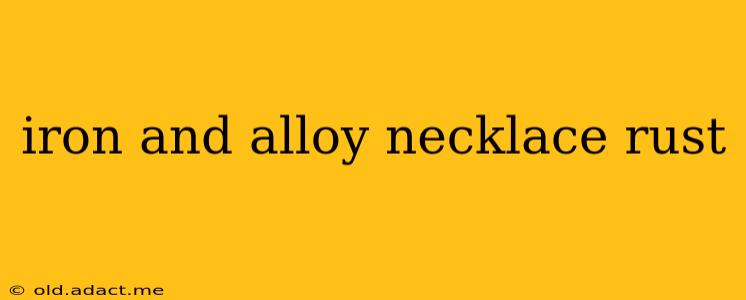Iron and alloy necklaces, while beautiful and affordable, are susceptible to rust. This guide will explore the causes of rust on these necklaces, how to identify different types of metal, and most importantly, how to prevent and treat rust to keep your jewelry looking its best.
What Causes Rust on Iron and Alloy Necklaces?
Rust is a form of corrosion that specifically affects iron and iron-based alloys. It occurs when iron reacts with oxygen and water (or moisture in the air) in a process called oxidation. The resulting iron oxide (rust) is a reddish-brown, flaky substance that weakens the metal. Several factors accelerate rust formation:
- Humidity: High humidity levels create a perfect environment for oxidation. Living in a coastal area or storing jewelry in a damp place significantly increases the risk of rust.
- Exposure to Water: Direct contact with water, whether from sweat, rain, or cleaning solutions, dramatically accelerates rust formation.
- Air Pollution: Exposure to pollutants in the air can also contribute to rust.
- Acidity: Contact with acidic substances, such as certain lotions, perfumes, or even the natural acidity of sweat, can speed up the corrosion process.
How Can I Tell if My Necklace is Iron or an Alloy?
Many necklaces are made from iron alloys, not pure iron. Identifying the specific metal is crucial for effective rust prevention. However, accurate identification often requires specialized testing. Here are a few clues:
- Magnet Test: Iron and most iron alloys are magnetic. If a magnet sticks to your necklace, it's likely made of an iron-based alloy.
- Visual Inspection: Pure iron typically has a grayish color. Alloys can have a variety of colors and finishes depending on the other metals mixed in. Look for markings on the necklace itself or its packaging; this information might indicate the metal composition.
- Weight: Iron is relatively heavy for its size. Comparing the weight of your necklace to similar-looking necklaces can offer a clue, though this is not a reliable method on its own.
- Professional Appraisal: For definitive identification, a professional jeweler or gemologist can perform tests to determine the precise metal composition of your necklace.
How Do I Prevent Rust on My Iron and Alloy Necklace?
Prevention is key when it comes to rust. Here's how to protect your iron or alloy necklace:
Proper Storage:
- Store your necklace in a dry, airtight container, such as a jewelry box lined with anti-tarnish fabric. Avoid storing it in plastic bags, as these can trap moisture.
- Keep your jewelry away from direct sunlight and extreme temperature fluctuations.
Careful Handling:
- Remove your necklace before engaging in activities that expose it to water or moisture, such as showering, swimming, or cleaning.
- Avoid wearing your necklace while applying lotions, perfumes, or other chemicals.
- Wipe your necklace gently with a soft, dry cloth after wearing to remove any sweat or oils.
Regular Cleaning:
- Clean your necklace periodically with a soft, lint-free cloth slightly dampened with warm water. Avoid using harsh chemicals or abrasive cleaners.
My Iron or Alloy Necklace is Already Rusty. What Should I Do?
Unfortunately, once rust sets in, it's difficult to completely remove without damaging the necklace. However, you can try these methods:
- Gentle Cleaning: Carefully clean the affected areas with a soft brush and a mild detergent solution. Rinse thoroughly and dry completely.
- Commercial Rust Removers: Some commercially available rust removers might be effective, but test them on a small, inconspicuous area first to ensure they don't damage the necklace's finish. Follow the manufacturer's instructions carefully.
Important Note: If the rust is extensive or deep, it’s unlikely that you can restore the necklace to its original condition. Consider seeking professional help from a jeweler for restoration or repair.
Can I prevent rust on a necklace that is a mixture of metals?
Yes, even if your necklace is a mixed metal piece, you can take preventative measures to avoid rust. The key is to focus on protecting the iron or steel components within the design. Proper storage (as mentioned above) and careful handling, avoiding direct contact with water and chemicals, are crucial, regardless of the other metals present. If the other metals are less reactive (like gold or silver), the iron components will still need protection.
What is the best way to clean a rusty iron necklace?
The best way to clean a rusty iron necklace depends on the extent of the rust. For minor surface rust, gentle cleaning with a soft brush and mild soapy water is the safest option. For more extensive rust, commercial rust removers might be considered, but always test these in an inconspicuous area first. Remember, significant rust damage may be irreversible. Professional cleaning by a jeweler should be considered for valuable or heavily rusted pieces.
By following these tips, you can significantly increase the lifespan of your iron and alloy necklaces and maintain their beauty for years to come. Remember that prevention is always the best approach.
